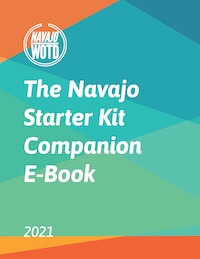Naaltsoos Sání
The Treaty Of Bosque Redondo
On June 1, 1868, the United States Government created the Treaty of Bosque Redondo with the Diné people after years of failing to force Navajos and Mescalero Apaches to establish a new homeland at Fort Sumner, New Mexico. That treaty is known today by Navajo people as Naaltsoos Sání, or the “Old Paper” or “the paper that is aged.”
Bearing the marks of Barboncito and many other Navajo headmen, Naaltsoos Sání allowed for the return of the Diné people to a reservation created inside Dinétah, the traditional Diné homeland. The signatures of General Sherman and the Indian Peace Commissioner S.F. Tappan represented the U.S. Government, which ultimately ratified the treaty 54 days later on July 25th, 1868.
In exchange for a promise of peace from the Diné people, the U.S. Government further agreed to provide sheep and staples, like corn, seeds, farming equipment, and rations, until the Diné people could sustain themselves. However, widespread accounts from the period following the return of the Diné people to the newly created Navajo Reservation demonstrated that supplies and provisions were not adequate nor equally distributed. Nevertheless, the Diné people reintegrated themselves into the land by rehabilitating abandoned farms, reconstructing debilitating homesteads, and keeping livestock according to cultural grazing practices.
Naaltsoos Sání also holds special place in American Indian law. In the decades that followed the creation of the Treaty of Bosque Redondo, the U.S. Supreme Court overturned rulings in state courts that dealt with issues of taxation and jurisdiction. The Supreme Court used Article 2 of the Treaty to argue that the Navajo people, so long as they had a functioning judicial system, had jurisdiction over cases that originated on tribal land. The Treaty, today, is one of the oldest legal documents that exist between the Navajo Nation and the U.S. Government. Naaltsoos Sání helped define and establish the idea of modern tribal sovereignty.
Though 150 years have passed since the signing of the Treaty of Bosque Redondo, many questions remain among the Navajo people. These questions deal with ideas about sovereignty, jurisdiction, self-determination, and more. There are even questions concerning the cultural meaning of the document.
Many traditionalists believe that interactions with Naaltsoos Sání are to be avoided because it was a direct result of Hwéeldi, the Navajo Long Walk. These ideas were shared widely leading up to the display of a copy of the Treaty in Window Rock. The Navajo Nation Museum arranged a ceremony ahead of it’s display because of this.
Naaltsoos Sání represents a significant point in Diné history. It is both a symbol of great resilience and of great struggle. For Diné people, Naaltsoos Sání thrust us into the Western world, where we continue to look to the story of the Treaty of Bosque Redondo for the strength it represents.
For more information, and to read the Treaty of Bosque Redondo, you can visit the National Museum of the American Indian’s webpage.
Original post date: .
